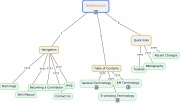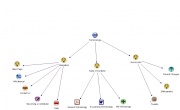Difference between revisions of "Mind Mapping"
From Learning and training wiki
| Line 10: | Line 10: | ||
__NOTOC__ | __NOTOC__ | ||
=='''Step by Step'''== | =='''Step by Step'''== | ||
| − | * | + | *Determine the topic that will be the focus of your thinking. The topic should be no more then a few words. |
| − | *Take a blank paper | + | *Take a blank paper - if you are using a software, open a new document - and write down the topic, wherever you want. It may be a good idea to start in the center of the paper, so as you have 360 degrees of freedom to continue your drawing. |
*To better identify and visualize the starting idea you can draw an image, using different colours. | *To better identify and visualize the starting idea you can draw an image, using different colours. | ||
| − | *Be open and have a creative attitude, trying to let ideas flow and | + | *Be open and have a creative attitude, trying to let ideas flow and writing all of them. |
| − | *Free associate without limitating your ideas | + | *Free associate without limitating your ideas; you can always add new branches and add more information later on. |
*Try to capture all your thoughts as rapidly as possible. | *Try to capture all your thoughts as rapidly as possible. | ||
| − | *Don't make any judgement | + | *Don't make any judgement; write everything you are thinking of. |
| − | *Allow organization. Once all the | + | *Allow organization. Once all the ideas have been added you can create links with the ones you left apart, and change the structure of your map. |
*Experiment with different ways of linking and emphasising different aspects, for example using colours and highlighters. | *Experiment with different ways of linking and emphasising different aspects, for example using colours and highlighters. | ||
=='''Practical Tips'''== | =='''Practical Tips'''== | ||
| − | *Use single words or simple phrases | + | *Use single words or simple phrases; they can convey the same meaning of a long sentence but are more efficient. |
| − | *Use colours to separate different concepts | + | *Use colours to separate different concepts; this will make the map easy to remember and will help showing the organization of the subject. |
*Use symbols and images, that are easier to remember the words. | *Use symbols and images, that are easier to remember the words. | ||
| − | *Use | + | *Use cross linkages, since information in one part of the drawing may relate with other on the other side of it.}} |
Revision as of 16:45, 10 October 2008
| A Learning methodology that consists of drawing diagrams to represent words, ideas, tasks, processes or other issues. It is a non-linear way of organizing information and a technique that allows to capture the natural flow of ideas about a central topic. Each idea or fact is written down and then linked by lines or curves to its major or minor (following or previous) idea or fact, thus creating a web of relationships. Its purpose is to focus attention, capturing and framing knowledge to facilitate the sharing of ideas and concepts.
Mind maps can be used to:
|
| In the table below there is a list of mindmapping tools. All of them are free-sources. You will also find some basic information about them, like if they are downoladable or on-line application, what kind of features and which degree of freedom in constructing the map they offer. By clicking the visualization image you will be able to see a sample map. |
| Tools | Type of Application | Special Features | Structure | Visualization |
|---|---|---|---|---|
| Freemind | To download
(1,51 KB) |
Link to files and web-sites | Ramification only horizontal. No freedom to change the structure. | |
| CMAP Tools | To downlad
(1,62 KB) |
Link to files and web-sites | Free structure. Every arrow connecting two nodes is supposed to contain a label | |
| Mindmeister | On-line. Two versions: Basic for free,
Premium to pay (4$ per month) |
Link to files and web-sites | Ramification only horizontal. No freedom to change the structure. | |
| Bubbl.us | On-line | Link to web-sites, impossible to link files | Free structure | |
| VUE | To download
(1,51 KB) |
Link to files and web-sites | Free structure. Possibility two add a label on the connection between two nodes. | |
| Compendium | To download
(1,58 KB) |
Link to files and web-sites | Free structure. Every node has to belong to a cathegory (question, decision, argument, idea..) | |
| Wisemapping | On-line | Link to web-sites, impossible to link files | Ramification only horizontal. No freedom to change the structure. | |
| Mind42 | On-line | Link to web-sites, impossible to link files | Ramification only horizontal. No freedom to change the structure. |
References
- ↑ astd-cac.net (08 July 2008) Wikipedia(08 July 2008) www.mind-mapping.co.uk (08 July 2008), www.illumine.co.uk (08 July 2008), www.mindtools.com (08 July 2008), www.thinksmart.com (8 October 2008), www.businessdictionary.com (8 October 2008)





